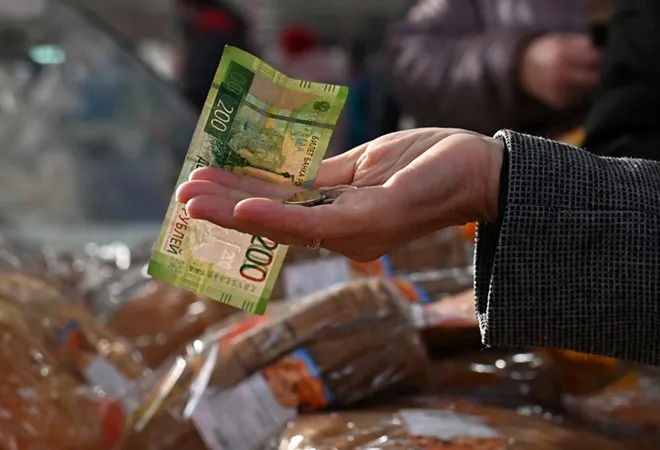
A year into the war in Ukraine and, despite the consequent worldwide economic sanctions, the Russian economy remains resilient, shrinking by a modest 2.2 percent in 2022 in stark contrast to the estimated 15 percent or greater as forecasted by the Biden administration and other western economists. According to the International Monetary Fund,
Russia’s economy is projected to outperform the United Kingdom’s (UK) in 2023, with the former growing 0.3 percent versus a contraction of 0.6 percent in the latter.
To place things in perspective,
Russia is now the world’s most heavily sanctioned country, according to United States (US) officials, with sanctions imposed mostly through executive orders. These measures are aimed at punishing Russia and blocking its access to the international financial system and bank accounts required to finance the war effort. Export controls are also targeted at curtailing the country’s ability to source computer chips and other products required to arm a contemporary military. In excess of 30 countries including the US, the European Union, the UK, Canada, Australia, and Japan are participants in this unparalleled effort involving price caps on Russian energy exports, freezing of Russian Central Bank assets, and restricting access to SWIFT, the leading system for worldwide financial transfers.
This article attempts to explain the resilience of the Russian economy in the face of such a comprehensive and unprecedented sanctions regime.
China’s role
Despite the economy shrinking in 2022, Moscow’s fiscal revenues have risen, as per the Russian government. This was mainly due to high global energy prices and Moscow’s efforts to redirect exports to alternative willing buyers such as China and India. China alone purchased US $50.6 billion worth of crude oil from Russia from March to December 2022—a 45 percent increase over the corresponding period of the previous year. Coal imports swelled 54 percent to US $10 billion, while natural gas imports including piped gas and LNG ballooned 155 percent to US $9.6 billion.
Moscow has also been purchasing billions of dollars’ worth of machinery, electronics, base metals, vehicles, ships, and aircraft from China, as elucidated in a US Congressional Research Service
report in May 2022. Chinese car brands, such as Havel, Chery, and Geely, have witnessed a massive expansion in their market share from 10 percent to 38 percent in the year post the departure of Western brands, and that share is likely to expand further in 2023 according to Russian research firm
Autostat. In the consumer electronics space, Chinese brands, which accounted for roughly 40 percent of the Russian smartphone market at the end of 2021, have now captured the industry with a 95-percent market share according to market research firm Counterpoint.
Finally, Russian firms have been utilising more yuan to conduct their burgeoning trade with China, since being severed from the SWIFT. Russian banks have also carried out more transactions in yuan to shield themselves against Western sanctions.
In the consumer electronics space, Chinese brands, which accounted for roughly 40 percent of the Russian smartphone market at the end of 2021, have now captured the industry with a 95-percent market share according to market research firm Counterpoint.
Monetary policy and economic structure
When the Ukraine conflict began and Western sanctions followed, there were fears in Russia of financial disarray, a Ruble crash, and a paucity of cash. But economic ruin and a bank run, such as those which had occurred after Russia’s 1998 debt default, did not take shape. This was partly due to the fact that Russia’s central bank promptly closed down markets, curtailed currency exchange, and raised interest rates to 20 percent. Additionally, Russia also had plenty of years to prepare for sanctions following the annexation of Crimea in 2014.
The structure of Russia’s economy also bolstered the country through a sanctions-heavy 2022. Largely unaltered from the Soviet era, state and state-owned companies constitute about two-thirds of gross domestic product (GDP), with small and medium-sized enterprises (SME) comprising only a fifth of GDP. Though this structure is not growth-friendly,
it can act as a stabiliser during bad times, as demonstrated during the COVID-induced shutdown.
Differences within the West
Because European and Asian nations depend more on Russian energy than the US, an export ban was difficult to negotiate within the alliance and necessitated compromises that required months to reach.
While Western countries have largely demonstrated unity on the need to punish Russia, differences have existed over the extent to which individual nations are willing to proceed. Because European and Asian nations depend more on Russian energy than the US, an export ban was difficult to negotiate within the alliance and necessitated compromises that required months to reach. Finally, the nations agreed on a US $60 per barrel price ceiling last December, which seems to be too little, too late.
Outlook
Although Russia’s economy has, thus far, proven surprisingly resilient in the face of sweeping Western sanctions, a rebound to the levels of well-being witnessed before the conflict seems to be a long way off as a higher share of government expenditure is routed towards the war effort in Ukraine. Further, the US is not yet done with its support to Ukraine, having announced more sanctions this week together with its allies.
The Russian central bank, for its part, has warned of the potential inflationary risk posed by the widening budget deficit and stated that it is more likely to increase interest rates from 7.5 percent this year than to reduce them. Thus, Russia is likely to incur an extensive and enduring opportunity cost as a result of continuing hostilities in Ukraine.
The views expressed above belong to the author(s). ORF research and analyses now available on Telegram! Click here to access our curated content — blogs, longforms and interviews.



 A year into the war in Ukraine and, despite the consequent worldwide economic sanctions, the Russian economy remains resilient, shrinking by a modest 2.2 percent in 2022 in stark contrast to the estimated 15 percent or greater as forecasted by the Biden administration and other western economists. According to the International Monetary Fund,
A year into the war in Ukraine and, despite the consequent worldwide economic sanctions, the Russian economy remains resilient, shrinking by a modest 2.2 percent in 2022 in stark contrast to the estimated 15 percent or greater as forecasted by the Biden administration and other western economists. According to the International Monetary Fund,  PREV
PREV


